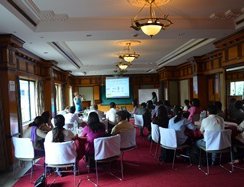
At a time when Nepal has been struggling to prevent child deaths from acute malnutrition, Action Cotre la Fail or Action against Hunger (ACF) has shown that it has effective tools to stop the death from Acute Malnutrition.
After launching successful programs in Saptari district, saving hundreds of children from Acute Malnutrition, ACF-Nepal recently organized a program to discuss whether Nepal can be part of its successful global campaign Generation Nutrition.
Attended by experts, members of Civil Society Alliance on Nutrition, government officials, representatives of various INGOs, the half day informal discussion gave a platform to share the experiences of Generation Nutrition and its successful implementation in African countries.
"With a vision, we can be the generation to stop children from dying of hunger," ACF officials said, adding "We are launching global campaign to fight acute malnutrition."
With a large number of children suffering from malnutrition, Nepal has been part of various global campaigns. According to a report on Multi-sector Nutrition Plan, Nepal is among the ten countries in the world with the highest stunting prevalence, a measure of chronic under-nutrition, and one of the top twenty countries with the largest number of stunted children.
“As Nepal has been part of the global movement on nutrition and is committed to improve nutrition status of its citizens on the basis of indicators applied universally, it has something to learn from Generation Nutrition,” said professor doctor Uma Koirala, president of Civil Society Alliance on Nutrition (CISAN).
ACF holds the view that silent killer like the Acute Malnutrition is predictable, preventable and treatable as well. In Saptari District, ACF has been treating the children through SAM treatment and saving hundreds of children annually.
As malnutrition is preventable, the government needs to increase action to tackle the cause of acute malnutrition. “Global and national policy frameworks should be established that create an enabling environment for tackling AM at different levels,” said Christelle Hure, Mission Support Advocacy officer of ACF’s head office.
“A world where no child dies from hunger or for lack of simple treatments is possible. All it needs is the political will to make it a reality,” said Hure. "If we can make governments change the way they set their priorities, children’s lives will be saved. That’s why an urgently needed Generation Nutrition is stepping up to act."
Hure said: “We consider it a scandal that in today’s world that there are still 52 million children under five suffering from acute malnutrition.
We have therefore decided to unite around the goal of ending young child deaths from acute malnutrition.”
What is acute malnutrition?
The recent and potentially life-threatening loss of weight (i.e. wasting) or oedema. It occurs as a result of recent shocks to a child’s nutritional status, whose immediate cause is a lack of food and/or a recent bout of illness.
A child suffering from the most severe form of acute malnutrition faces a risk of dying that is nine times higher than that of his or her healthy counterpart.
“As Generation Nutrition is a global campaign, it brings together a diverse and growing group of civil society organisations” said Hure.
The potentiel impact on programs will émerge only when government made greater commitment to tackle undernutrition. It will also raise awareness about the work of nutrition NGOs and get media attention.
“Acute Malnutrition (AM) has remained unchanged over the last decade in Nepal with 11 percent in 2001. Every year severe AM causes at least 5000 deaths. For those children who survive the damage caused by AM is serious and often irreversible. Although treatments cost only $22 per child, only one in ten children have access,” said Dr. Ojaswi Acharya, head of Nutrition and health ACF.
“The issue of AM is not well known and well understood among decision makersand the nutrition sector still low in the Ministry of Health.”
Need for more sustainable funding to address the issue of AM on a long-term basis. Nepali health system still shows weaknesses and needs to be strengthened to better address malnutrition
We are the generation to end the outrage of children dying due to inadequate nutrition.We must raise awareness of the critical nature of AM and infant mortality in order to make this a high priority for government agencies, international organizations and donors,” said Hure.
Experts say that Nepal’scommitment to reduce wasting to 5% by 2017 is achievable, through, an improved knowledge of AM, the conduction of governmental nutrition-specific survey in high burden areas and an improved access to the treatment of AM.
“Inclusion of nutrition (treatment and prevention) in the District Health Plan and Development plan, secured and sustainable national and external funding for both treatment and prevention of AM is a major achievement in Nepal.
As Nepal is working to make progress, the tools used by Generation Nutrition are likely to help tackle acute malnutrition in the under five children further.
- MELAMCHI WATER SUPPLY: No Interruption During Monsoon
- Jun 25, 2025
- KOREAN RETURNEES: Successful Integration
- Jun 25, 2025
- UPPER TRISHULI-1: Engaging With Local
- Jun 25, 2025
- IME GROUP: Twenty Five Years Of Journey
- Jun 24, 2025
- NEPAL’S AIR POLLUTION: A Growing Health Concern
- Jun 24, 2025















